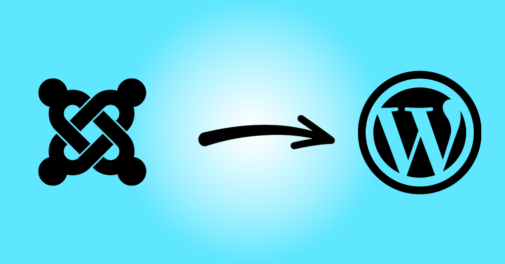Greetings! I'm Aneesh Sreedharan, CEO of 2Hats Logic Solutions. At 2Hats Logic Solutions, we are dedicated to providing technical expertise and resolving your concerns in the world of technology. Our blog page serves as a resource where we share insights and experiences, offering valuable perspectives on your queries.
If you are planning to migrate your Joomla to WordPress, you are in the right company. A lot of website owners have been transitioning and for a good number of reasons. Whereas Joomla has been good for years, WordPress is more flexible and easy to use than Joomla. It is easier to manage, WordPress has a plethora of plugins that help provide higher SEO capabilities and many more, making WordPress one of the best Joomla Alternatives.
In this blog post, we will try to explain why the Joomla to WordPress switch can be the best choice for your website. If you are stressed by the change, I will explain everything in detail, and then you will be able to switch with confidence!
For those seeking a smooth migration without technical worries, we’re here to support you.
Step-by-Step Guide to Joomla to WordPress Migration
Step 1: Backup Your Joomla Site
Use a backup extension or manually export your database and files to ensure a complete backup.
Step 2: Choose a WordPress Hosting Provider
Choose a host that has good compatibility with WordPress; be sure that the host provides enough resources for the site.
Step 3: Install WordPress
Install WordPress on your new hosting environment, using your host’s auto-install or a manual installation.
Step 4: Install the FG Joomla to WordPress Plugin
Go to the WordPress admin dashboard, navigate to Plugins > Add New, search for FG Joomla to WordPress, and install it.
Step 5: Configure the Plugin
Following activation, go to the plugin settings and type in your Joomla site address, database credentials, and any other required parameters.
Step 6: Import Content
Click on the Import Content button in the plugin settings. The plugin will transfer your articles, categories, and media from Joomla to WordPress.
Step 7: Review and Adjust
After the import, check your WordPress site for formatting issues, missing images, or broken links, and make necessary adjustments.
Step 8: Set Up Permalinks
Configure permalinks in WordPress to match your Joomla URL structure, which helps maintain SEO rankings.
Step 9: Test Functionality
Ensure that all features, forms, and functionalities are working correctly in the new WordPress environment.
Step 10: Launch Your New Site
Once satisfied with the migration, update your DNS settings to point to your new WordPress site.
Benefits of Moving from Joomla to WordPress
Joomla to WordPress migration offers several significant advantages that can enhance your website’s functionality and user experience. Here are key benefits to consider:
- User-Friendly Interface
WordPress provides user-friendly intuitive dashboard features to simplify content management. The end idea is to make things easier for users of all skill levels to create and edit posts, pages, and media without extensive technical knowledge. - Extensive Plugin Ecosystem
Plugins are there for the rescue to extend your website’s functionality. From SEO optimization tools to e-commerce solutions. This level of flexibility allows you to easily add features and improve website performance. - Responsive Themes
To enhance the look of your website, WordPress offers numerous themes that look great for your business. A positive user experience is what makes customers come back to your website again and again. This in turn will improve your sales and search engine rankings. - Strong Community Support
The WordPress community is large and active, providing extensive documentation, forums, and support. This resource can be invaluable during and after your migration process. - SEO Optimization
WordPress in itself is optimized for search engines, with plugins available to upgrade your SEO strategy. This can help improve your site’s visibility and attract more organic traffic. - Improved Security
While both platforms offer security measures, WordPress regularly updates its core software and plugins, providing robust security features that can help protect your site from vulnerabilities. - Easier Content Management
WordPress’s content management system allows for straightforward organization and categorization of content, making it easier to maintain a blog or website with multiple authors.
Joomla vs. WordPress: Key Differences
When comparing Joomla vs. WordPress, several key differences emerge that can impact your choice of platform:
| Feature | Joomla | WordPress |
| Development Support | Hard to find development support | Easy to find development support |
| Cost | Maintenance costs are high | Low maintenance cost |
| User Management | Advanced user roles and permissions | Simpler user management; suitable for most websites |
| E-Commerce | Support e-commerce, but more complex to set | Easy to integrate with WooCommerce, easy to manage |
| SEO Capabilities | Extension required | In-built SEO features and plugins are available |
| Community Support | Small community | Large community |
| Security | Regular updates are not available | Regular updates and security plugins are available |
| Best Use Case | Complex sites requiring advanced user management | Blogs, eCommerce, and general websites looking for ease of use |
Try Joomla to WordPress Migration with Experts
Migration is a serious process, and it has to be done without losing data or interrupting the existing store. It is always suggested to consider an expert eCommerce agency to handle Joomla to WordPress migration.
2Hats Logic is a complete eCommerce agency that provides all e-commerce services. Carry out your migration with experts. Our team handles the migration without losing your data, affecting SEO, performance, security, or online operations.
Joomla to WordPress Migration: Post-Migration Checklist
Migrating from Joomla to WordPress is a big step, and ensuring everything runs smoothly post-migration is essential. This checklist will guide you through the key tasks to get your new WordPress site optimized, secure, and SEO-ready.
- Choose a Permalink Structure
Set up a clean, SEO-friendly URL structure in WordPress before going live. Use either post name (e.g., domain.com/post-title) or category/postname (e.g., domain.com/category/post-title) structure to maintain readability and search engine visibility. Remember to match your old Joomla URL pattern if possible to minimize redirect needs.
- Set Up Redirects & Check Broken Links
Implement 301 redirects from your old Joomla URLs to the new WordPress URLs to preserve SEO value and user experience. Run a thorough broken link check using tools like Broken Link Checker to identify and fix any dead links, ensuring all internal and external links point to the correct destinations.
- Install & Configure Essential WordPress Theme
Select and install a WordPress theme that matches or improves upon your Joomla site’s design. Focus on mobile responsiveness, loading speed, and compatibility with your must-have features. Configure theme settings, including menus, widgets, and homepage layout, before going live.
- Verify Content Migration Integrity
Check that all pages, posts, images, and media files have transferred correctly and maintain their original formatting. Pay special attention to special characters, tables, and custom HTML, and ensure all images are properly displayed and linked within your content.
- Security & Performance Setup
Install essential security plugins, set up SSL certificates, and create secure admin credentials. Configure caching and performance optimization plugins to ensure your new WordPress site loads quickly. Set up regular backup schedules and test the restore process.
- SEO Elements & Analytics
Verify that all meta titles, descriptions, and schema markup have transferred correctly. Set up WordPress SEO plugins like Yoast or Rank Math, generate a new XML sitemap, and ensure your analytics tracking codes are properly installed. Submit your new sitemap to search engines through their respective webmaster tools.
Following this checklist will help you maintain your site’s performance, security, and SEO value after the migration. Use it as a final step to ensure your WordPress site is ready for launch.
Conclusion
Migrating from Joomla to WordPress is an important step for your website. WordPress offers flexible and robust features to enhance your website’s efficiency. Choosing WordPress also means your site is well-prepared for future development, benefiting from improved SEO and responsiveness. Select the right eCommerce platform that supports your website in the long term. Feel free to consult with eCommerce experts to discuss any questions and help you make the right decision.
FAQ
How long will it take to migrate my Joomla site to WordPress?
For a standard website, the migration typically takes 2-4 hours of work. The exact time depends on your site's size and complexity.
Will I lose my SEO rankings after moving to WordPress?
No, if the migration is done properly with correct URL redirects and metadata transfer. Just make sure to keep your URLs and meta descriptions intact.
Do I need to be tech-savvy to migrate my website?
While basic technical knowledge helps, you can use migration plugins or hire a professional. Many migration tools provide step-by-step guidance.
Can I keep my Joomla website running during the migration?
Your Joomla site can stay live while you build the WordPress version in a staging environment. You'll only need to take it down briefly during the final switch.
What happens to my Joomla images and files after migration?
All your media files will be transferred to WordPress's media library. You won't lose any content or files during the migration.

Related Articles







